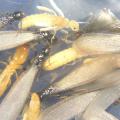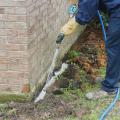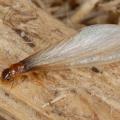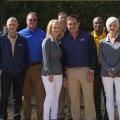Termite Facts (for eastern subterranean termites or Formosan termites)
- Termites are one of the few animals able to utilize wood/cellulose as a food source.
- Termites have symbiotic protozoa and other microbes in their gut that digest cellulose.
- Eastern subterranean termites are native termites that occur throughout the eastern United States.
- Eastern subterranean termites occur in all 82 counties of Mississippi.
- Mature eastern subterranean termite colonies contain around 50,000 to 200,000+ termites.
- Formosan termites are non-native termites, first detected in Mississippi in 1984.
- Formosan termites are currently known to occur in 25 counties in Mississippi.
- Formosan termite colonies can contain more than one million termites, but are usually smaller.
- Unlike ants and bees, termite workers may be either male or female.
- Male reproductive termites are known as kings.
- Unlike ants and bees, king termites live inside the colony with the queen.
- Primary termite queens and kings may live 10 to 15 years or longer.
- An established termite queen may lay more than 1000 eggs per day.
- Older termite colonies may also contain secondary and tertiary reproductive termites.
- Total egg production of secondary and tertiary reproductives may exceed that of the queen.
- Eastern subterranean termites are beneficial to southern forests, helping decompose dead trees.
- Termite workers do not have eyes; they are sightless.
- Termites reproduce by producing winged reproductive termites, known as swarmers.
- Swarmers leave the parent colony, find a mate, and attempt to start a new colony elsewhere.
- Swarmers shed their wings shortly after swarming.
- It takes a termite colony around five years or more to grow large enough to produce swarmers.
- Fire ants readily prey on termite swarmers attempting to found new colonies.
- Termites forage primarily in the top six to twelve inches of soil.
- Termites forage randomly by tunneling through soil and over stone until they encounter wood.
- Once they encounter a food source, workers recruit others to the source and begin feeding.
- Older termite colonies do not have a single, central nest.
- A mature termite colony will have many different “nest sites” (places where eggs are laid).
- An average suburban landscape will contain several different termite colonies (up to 25/acre).
- Finding eastern subterranean termite swarmers indoors is a sure sign the building is infested.
- Buildings that are not properly protected from termites will become infested by termites.
Dr. Blake Layton, Extension Entomology Specialist
Department of Entomology, Mississippi State University
Phone: 662-325-2960
Email: blake.layton@msstate.edu
Publications
News
Mississippi’s native subterranean termites have started swarming, and these structure-destroying insects will continue to swarm across the state over the next few months.
John Riggins, professor of forest entomology in the Mississippi State University Department of Agricultural Science and Plant Protection, said termites swarm to produce new colonies when the weather warms up, often after a rain.
Termites exist all over Mississippi and will eventually infest and damage any structure that contains wood or other cellulose components unless you properly protect those structures.
Invasive Formosan subterranean termites were first found in the state 40 years ago, and soon, these dangerous pests will swarm and threaten unprotected structures in about one-third of Mississippi’s counties.
Santos Portugal, Mississippi State University Extension Service urban entomologist, said Formosan termites typically swarm in the millions from early May to early June. They have the ability to infest and significantly damage structures much more quickly than native subterranean termites.
Success Stories
A dream of the Mississippi Pest Control Association and the Mississippi State University Extension Service is coming true after more than 20 years, thanks to a generous donation by one of Mississippi’s oldest pest-control companies.






